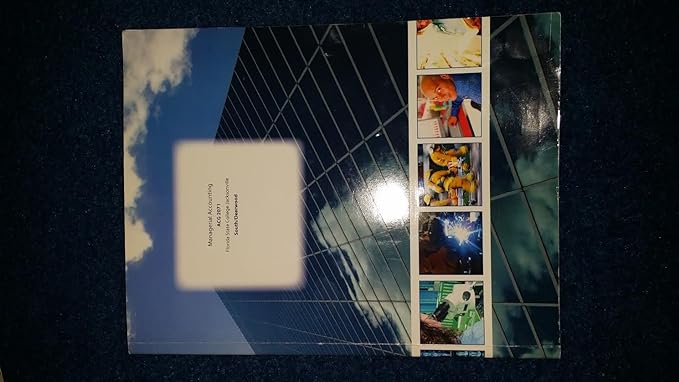Question
TEDS Ltd (TEDS) is a company which manufactures clothes for sale to retail chain stores. As TEDS operates in a competitive market, it has minimal
TEDS Ltd (TEDS) is a company which manufactures clothes for sale to retail chain stores. As TEDS operates in a competitive market, it has minimal control over selling prices and quantities demanded. In order to expand the product range, at the beginning of 2020 TEDS purchased a factory manufacturing leather sandals. The purchase price included finished goods inventory. At the end of the first year of operation under new management, the companys accountant prepared the actual Statement of Comprehensive Income for the twelve months ending 31 December 2020 as follows: Sales Opening inventory of finished goods Cost of manufacture Variable costs Fixed costs Closing inventory of finished goods Cost of goods sold Gross profit Fixed administrative expenses Variable selling costs Net loss You are provided with the following additional information: 1. Inventory of finished goods was stated at fully absorbed factory cost, with actual fixed manufacturing overhead being allocated on the basis of units produced. Inventory is valued on the FIFO basis. There was no opening or closing inventory of raw materials or work- in progress. 2. The factory has the manufacturing capacity to produce 75 000 pairs of shoes, however due to persistent scheduling problems and poor management of the production line, only 22 000 pairs of shoes were produced historically since incorporation of the company including the twelve months to 31 December 2020. 3. Selling costs represent distribution expenses, which were 10% of the sales value of goods sold. 4. It is not possible in the foreseeable future for the Factory Manager to change variable costs per unit, fixed costs per annum, selling price per unit, selling costs per unit or the number of pairs of sandals sold each year. You were also informed that the directors of TEDS were unhappy with the performance of the factory in 2020 and consequently appointed a new Factory Manager on a short-term contract for two years commencing 1 January 2021. Under its terms, he was to have complete control over the scheduling of production. To provide an incentive, it was agreed that his remuneration should be 10% of net profit before deducting the incentive expense. It was further agreed that for this purpose, profit should be calculated applying the accounting policies adopted in preparing the 2020 actual Statement of Comprehensive Income shown above. In 2021 the factory produced 75 000 pairs of sandals the limit of its output capacity, after the new factory manager was able to permanently overcome the scheduling problems and poor management of the production line. However, only 50 000 pairs of sandals were sold. In 2022 the factory again produced 75 000 pairs of sandals and 50 000 pairs of sandals were again sold. As anticipated at the end of 2020, variable costs per unit, fixed costs per annum, selling price per unit, and selling costs per unit all remained at their 2020 levels during both 2021 and 2022. Expansion to product range: TEDS is considering expanding its product range in 2023 from selling sandals only, to selling sandals as well as high end takkies and winter boots. This would necessitate reducing the production of sandals as the factorys manufacturing capacity is limited to 75 000 pairs of shoes. Due to the warm tropical climate in Durban, TEDS is budgeting on 50% of the manufacturing capacity being used in the production of sandals. The balance of the production capacity will be evenly split between takkies and boots. TEDS expects the selling price and total variable cost of sandals to remain at the previous years level. It is expected that the selling price of takkies will be R160 per pair and the variable costs as a percentage of selling price will be in the same proportion as for the sandals. The selling price of the boots is budgeted at R210 per pair and variable manufacturing costs will be 50% of selling price due to the amount of fabric that is required in the production of the boots. The variable selling cost percentage will, however, be in the same proportion as those for sandals and takkies. It is anticipated that the fixed manufacturing cost will increase by 10% and the fixed administration costs by 15% due to the diverse product range. REQUIRED: 1. Using the stated method of valuing finished goods inventory, calculate the actual net profits earned by the factory in 2021 and 2022 and the Factory Managers remuneration for those two years. (21) 2. Without producing any additional Statements of Comprehensive Income, reconcile the 2020, 2021 and 2022 absorption costing profits to variable costing profits/losses, before accounting for the Factory Managers remuneration. (7) 3. Write a report to the management committee in which you: Assess the performance of the Factory Manager in both 2021 and 2022 and discuss the implications of applying full absorption cost rather than variable cost inventory valuation in the circumstances described; and (9) Include a brief overview of the differences between full absorption costing and variable costing. (6) 4. Calculate the budgeted break-even sales quantities, in units, for 2023 on the assumption that the takkies and boots are manufactured in addition to sandals in the budgeted proportions. (7 marks)
Step by Step Solution
There are 3 Steps involved in it
Step: 1

Get Instant Access to Expert-Tailored Solutions
See step-by-step solutions with expert insights and AI powered tools for academic success
Step: 2

Step: 3

Ace Your Homework with AI
Get the answers you need in no time with our AI-driven, step-by-step assistance
Get Started


